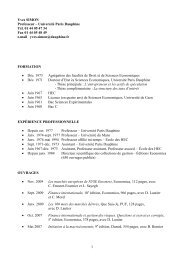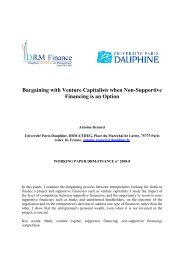Corporate governance and earnings management ... - CEREG
Corporate governance and earnings management ... - CEREG
Corporate governance and earnings management ... - CEREG
Create successful ePaper yourself
Turn your PDF publications into a flip-book with our unique Google optimized e-Paper software.
References<br />
AAA (1948). Accounting concepts <strong>and</strong> st<strong>and</strong>ards underlying corporate financial statements. The Accounting<br />
Review, 22(October), 339-340.<br />
AAA - Financial Accounting St<strong>and</strong>ards Committee (1998). Response to FASB special report "issues associated<br />
with the FASB project on business combinations". Accounting Horizons, 12(1), 87-89.<br />
AAA - Financial Accounting St<strong>and</strong>ards Committee (1999). Response to FASB invitation to comment on<br />
methods of accounting for business combinations: Recomm<strong>and</strong>ations of the G4+1 for achieving convergence.<br />
Accounting Horizons, 13(3), 299-303.<br />
Abrutyn, S. & Turner, R. (1990). Taxes <strong>and</strong> firm's dividend policies: Survey results. National Tax Journal, 43,<br />
491-496.<br />
Adler, H., Düring, W. & Schmalz, K. (1995-2000). Rechnungslegung und Prüfung der Unternehmen. Stuttgart:<br />
Schaeffer-Poeschel.<br />
Aglietta, M. & Rebérioux, A. (2004). Dérives du capitalisme financier. Paris: Albin Michel.<br />
AIA (1917). Uniform accounting. Journal of Accountancy, June, 401-433.<br />
AIA (1944). Accounting research bulletin (ARB) No. 24: Accounting for intangible assets. New York: American<br />
Institute of Accountants.<br />
AIA (1950). Accounting research bulletin (ARB) No. 40: Business combinations. New York: American Institute<br />
of Accountants.<br />
AIA (1953). Accounting research bulletin (ARB) No. 43: Restatement <strong>and</strong> revision of accounting research<br />
bulletins, chapter 5, 'accounting for intangible assets' <strong>and</strong> chapter 7c 'business combinations'. New York:<br />
American Institute of Accountants.<br />
AIA (1957). Accounting research bulletin (ARB) No. 48: Business combinations. New York: American Institute<br />
of Accountants.<br />
AICPA (1970a). APB opinion No. 16: Business combinations. New York: American Institute of Certified Public<br />
Accountants.<br />
AICPA (1970b). APB opinion No. 17: Intangible assets. New York: American Institute of Certified Public<br />
Accountants.<br />
Amiaud, A. (1920). Traité théorique et pratique des comptes de réserves dans les sociétés anonymes. Paris:<br />
Librairie Sirey.<br />
Anonymous (1913). Goodwill: Its nature, value, <strong>and</strong> treatment in the accounts. The Accountant, December 6,<br />
816-823.<br />
Anonymous (1919). Goodwill. The Accountant, March 15, 199-200.<br />
Anonymous (2001). L'information financière: 100 groupes industriels et commerciaux. France: CPC, Meylan.<br />
Armour, J., Deakin, S. & Konzelmann, S. J. (2003). Shareholder primacy <strong>and</strong> the trajectory of UK corporate<br />
<strong>governance</strong>. Working Paper No.266.<br />
Arnold, J., Eggington, D., Kirkham, L., Macve, R. & Peasnell, K. (1994) Institute of Chartered Accountants in<br />
Engl<strong>and</strong> <strong>and</strong> Wales, London.<br />
Arthur Andersen (1970). Before the Accounting Principles Board: Proposed opinion: Business combinations<br />
<strong>and</strong> intangible assets: Brief <strong>and</strong> argument of Arthur Andersen & Co.: Arthur Andersen & Co.<br />
ASB (1993). Discussion paper: Goodwill <strong>and</strong> intangible assets. London: Accounting St<strong>and</strong>ards Board.<br />
ASB (1997). Financial reporting st<strong>and</strong>ard (FRS) 10: Goodwill <strong>and</strong> intangible assets. London: Accounting<br />
St<strong>and</strong>ards Board.<br />
ASC (1984). Statement of st<strong>and</strong>ard accounting practice (SSAP) 22: Accounting for goodwill. London:<br />
Accounting St<strong>and</strong>ards Committee.<br />
ASC (1990). Exposure draft 47: Accounting for goodwill. London: Accounting St<strong>and</strong>ards Committee.<br />
Avery, H. G. (1942). Accounting for intangible assets. The Accounting Review, 17(4), 354-363.<br />
Ayers, C., Lefanowicz, C. E. & Robinson, J. R. (2000). The financial statement effects of eliminating the<br />
pooling-of-interests method of acquisition accounting. Accounting Horizons, 14(1), 1-19.<br />
Baetge, J., Kirsch, H.-J. & Thiele, S. (2002). Bilanzen. Düsseldorf: IDW-Verlag.<br />
Baker, H. K., Powell, G. E. & Veit, E. T. (2002). Revisiting managerial perspectives on dividend policy. Journal<br />
of Economics <strong>and</strong> Finance, 26, 267-283.<br />
Ballwieser, W. (1996). Accounting treatments for goodwill <strong>and</strong> other intangible assets in Germany. Issues in<br />
Accounting Education, 11(2), 479-481.<br />
Barth, K. (1953). Die Entwicklung des deutschen Bilanzrechts und der auf ihm beruhenden Bilanzauffassungen.<br />
Stuttgart: selbst-Verlag.<br />
Batardon, L. (1931). L'inventaire et le bilan. Etude juridique et comptable. Paris: Dunod.<br />
Baums, T. & Fraune, C. (1995). Institutionelle Anleger und Publikumsgesellschaft: Eine empirische<br />
Untersuchung. Die Aktiengesellschaft, 40(3), 97-112.<br />
Beisse, H. (1993). Glaübigerschutz-Grundprinzip des deutschen Bilanzrechts. In Festschrift für Karl Beusch zum<br />
68. Geburtstag am 31 oktober 1993 (Ed, Beisse, H.) Berlin/NewYork, 77-97.<br />
68



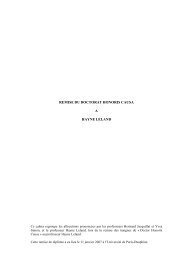

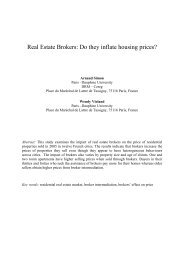
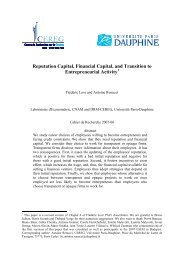

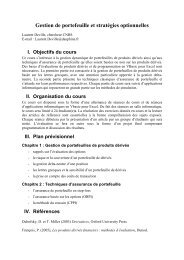



![& 6 ] ^ F ]^ - CEREG - Université Paris-Dauphine](https://img.yumpu.com/33326502/1/184x260/-6-f-cereg-universitac-paris-dauphine.jpg?quality=85)

